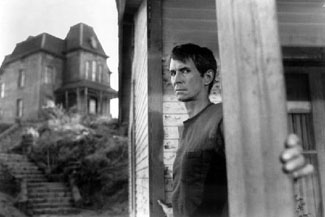Chapter Two: Psycho II
By Brett Beach
May 26, 2011
There is also an obvious attempt by Holland to balance the project’s slightly more high-class status with the graphic violence that the young audience of the time might expect. Thus, two of the six murders are spread out over the first 90 minutes, and are relatively tame, while the final 20 minutes deliver death by knife through the mouth, knife to the chest followed by a fall over a second-story banister, and death by poisoning and a shovel to the head. In a very subtle wink to slasher films, there is a teen as a victim, and he does get killed while enjoying a doobie, but before he can get past second base with his lady friend. (On a side note, long before I saw the film, I read Mad Magazine’s parody, aptly named “Sicko, Too” which proved to be just as bloody as its inspiration, and perhaps more disturbing. It certainly left visual imprints in my mind.)
Franklin has two key assets at his disposal, and he makes wonderful use of both to help the film score as a minor success. Without the combination of the iconic set — the house above and the adjoined 12 units below — and Anthony Perkins' relationship to the character that came to define him, Psycho II would be more apparent as a blatant cash grab.
Production designer John Corso (who followed this project by working as PD on most of John Hughes’ films for the rest of the decade) finds a way to give the buildings the psychic weight they need to compete with the mental baggage that begins to consume Bates. Psycho used the house sparingly, but Psycho II goes above and below and over into side parlors and down back staircases (and yes, into showers), at times leaving the impression that the Bates House is really an M.C. Escher design where all paths leads to everywhere and nowhere simultaneously. In brightly lit color, the property as a whole seems a lot seedier and creepier.
Perkins may have never been able to escape from the specter of Bates, especially in the final act of his film career where he played psychos of various degrees in any number of forgettable films, but he was always a skilled actor (Oscar-nominated and Cannes-feted) and he refrains from ever phoning in his performance. The passage of actual time, with Perkins going from his late 20s in the original to pushing 50 here, is rendered not only with the lines in his face or gray in his hair, but in the twitch of his features and behind his eyes as well.
With 22 years to think about this character and have his career defined by him, Perkins responds with a deeply felt duality. There is the frayed nerves live wire side as Norman strives to stay sane and finds the world conspiring against him, and then there is the calm descent back into madness, with a pinch of knowing in a line reading and a slight nod and wink in the direction of camp, letting Perkins at least have a little fun with the character. Wearing a never-ending series of khakis and ill-fitting shirts, Norman seems so benign early on it’s almost too hard to imagine him doing whatever a mother might request of her son. Almost.
Next time: After a nearly three-decade interval, Jeff Bridges once again becomes the ghost in the machine.
Continued:
1
2
3
|
|
|
|




